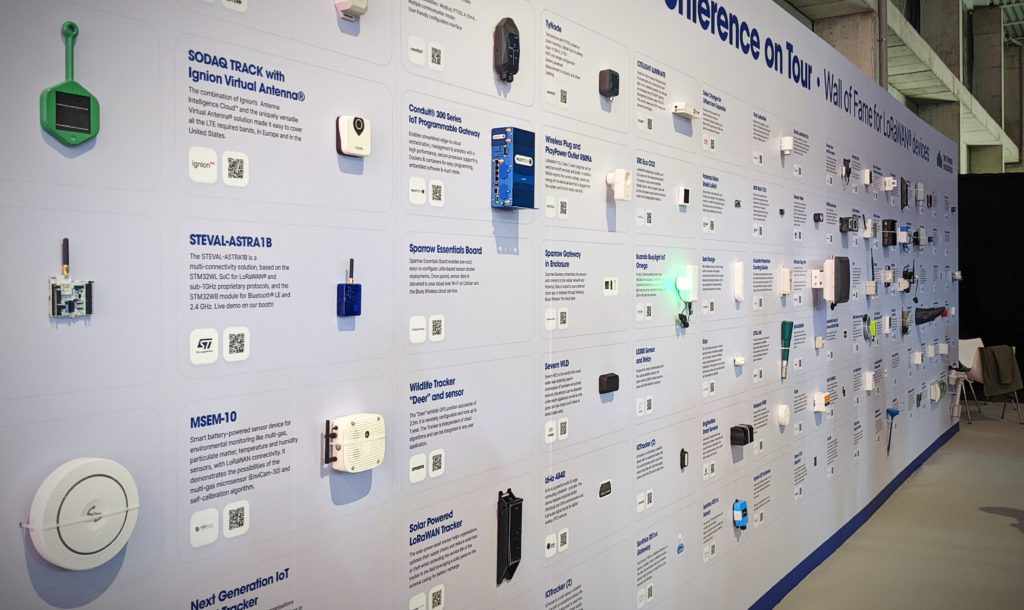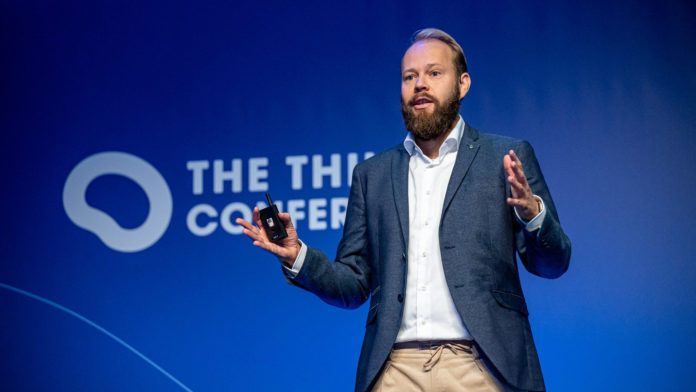IoT Solutions World Congress (IOTSWC) in Barcelona is not just about cellular, of course. But its proximity in the calendar, as January turns to February, to the city’s big MWC monster-mash at the end of the month – and the closer alignment of their keynote agendas as IoT is confirmed as the default vehicle for industrial change, and machines are acknowledged as more interesting than people (at least in terms of what comes out of them) – means it is still something of a surprise to find the LoRaWAN brigade lurking in the corner.
But here they are, inside the entrance to hall 4 of the Fira – and they are not lurking, actually, but projecting loudly from the back of the room, as if to say, ‘We built this market and won’t be ignored’. The Things Industries (TTI), the Amsterdam collective which has corralled a noisy community of IoT makers around its network stack (ThingsStack, the central part of the TTI offer) and network starter-kit (via The Things Network / TTN), is on tour here with its wall-of-fame display of LoRaWAN hero-devices (see image below).

In Barcelona, in the adopted home of Cellular Inc, it works as a neat reminder of the hardware that helped to build IoT. It illustrates the team sport of IoT, with all its disjointed gameplay, and – like we said before – it is arguably the best in-show at IOTSWC, alongside group efforts by AWS and ST Micro. And here is TTI co-chief Wienke Giezeman, sticking out a hand, happy to chat, as delegates mill about his wall display. So what’s new, Wienke? He has a sum for us: a million devices at €200 each (running total: €200 million), delivering a five-times return (€1 billion).
This is the cumulative value (for customers) of the IoT traffic on the TTI server, he reckons. “I mean, you pick the multiplier,” he says. “But a water meter, say, would have that kind of return in five years, easily. Even a conservative estimate of the efficiencies these solutions deliver would put the total value at between €500 million and €1 billion.” Ninety-five percent of IoT cases are about efficiency, he says, of one sort or another – in energy usage, in labour resources, just in cash flows.
Actually, his billion-euro ROI calculation has not advanced much since we last caught up, in Amsterdam in September. More interesting this time, perhaps, is his argument that LoRaWAN, conceived for low-power sensors in wide-area (WAN) spaces, triumphs most clearly in local-area (LAN) industrial settings – for bespoke automated intelligence projects. It should be rebadged as LoRaLAN, as the king-tech in the private LPLAN court, the suggestion goes – almost as if cellular-based NB-IoT and LTE-M have the market for national and international WAN roaming.
Giezeman’s comments might be taken only as a reflection of how the TTI-end of the market is engaged with the LoRaWAN narrative. Certainly, new developments with community-built and satellite-aided IoT, and even just with national rollouts and integrations, show the LoRaWAN community has not given up on public IoT. But he is talking fairly freely, and his commentary reflects what the market thinks: that LoRaWAN’s great success, recently, is to have started to deliver palpable scale as a private network technology.
Giezeman says: “I don’t see a business case for public LoRaWAN. I see a business case for opportunity-driven private network deployments – based on an essential anchor case, which creates a platform for other applications on top… It is almost like, ‘LPWAN is dead, long live LPLAN’. Private LoRaLAN is the great legacy of LoRaWAN. This toolkit to make really awesome private IoT solutions has been created along the way. And it is not playing second fiddle in terms of scale. It is driving a massive amount of business value, and is scaling across the world.”
He cites a couple of examples, which RCR Wireless (via Enterprise IoT Insights originally) has already covered: Connexin has deployed 150,000 meters for Severn Trent Water in the UK; Assek has installed 47,000 air quality sensors in schools in Canada. The million-odd devices on its ThingStack server offer further proof, he says. “We have these massive-scale business cases based just on people building their own local-area IoT networks,” he says, also explaining the TTN/TTI scale-up process. “TTN is an experimental platform, to go from zero to one; TTI gets you from one to a million.”
The challenge with IoT for enterprise users – as Enterprise IoT Insights used to write about all the time – is how to match-make suppliers to compose coherent and prudent tech solutions to private business problems. The challenge for tech suppliers is to just to assist, to devise the right solutions with the right partners – and then to replicate them in similar scenarios. It is not a box-shifting sales market, but a consultancy-led one, notes Giezeman. For him, with his cloud server platform, and wall of developer partners, the focus is just to provide options, and reassurance.
He explains: “The market is massively fragmented. There are lots of problems and lots of solutions. Customers want to cherry-pick the best network server, the best device, the best gateway. But you can’t push an IoT solution. You can’t dictate what the customer should take. You can’t just box-up a temperature sensor – because there are too many temperature measures and too many ways to measure. Plus there’s regulation – like with food compliancy. All you can do is prove you’re the best, and trust the customer will pick you.”
He adds: “The device makers are the heroes in this. They are taking the risk – not just with development, but with cash flow. So we want to support them – because if they’re successful, then so are we. We’re just here to make sure their devices are available 99.9 percent of the time. We don’t want to create conflict – by going direct to the customer, by making devices, by building networks. We turn those requests down. We just want to deliver consistency, and product leadership and operational excellence.”
Is that what keeps you awake at night? “What keeps me awake is missed opportunities – how to help partners replicate a few successful cases, so they literally copy-and-paste and help new customers achieve five-times value. Because then we get into exponential growth. The technology is global, right? We are connecting mines in Chile and cows in Australia. So, what can we offer in terms of global business development capability? What can we contribute – for free, essentially? We don’t need a penny on the dollar as a platform fee – unless maybe they’re successful.”
There has been a strategic unravelling in the IoT industry in its ongoing quest for scale, resulting in a rush of disposables and mergers in late 2022. As written before, the tech supplier market has given up on building its own rarefied vertical domain expertise, except via partnerships. Instead, it is focused on the whole horizontal solution-set. Giezeman reflects: “The core horizontal players went vertical because they thought it was an opportunity, but the only thing they did was hire account managers and sales managers – and now they’re moving backwards again.”
What about Semtech’s $1.2 billion deal for Sierra Wireless – which sees the owner of the non-cellular LoRa tech take charge of a major cellular IoT venture? Does it acknowledge implicitly that the non-cellular side has triumphed as the alpha in the IoT contest, or does it suggest tacitly that it has lost, and decided to throw-in with cellular on global LPWAN – in line with Giezeman’s LoRaLAN/LPLAN assessment? He shrugs, and says simply: “It is a great move to expand your toolbox. I’m happy for them – that they pulled off this deal to make a more complete portfolio.”
Does it have any bearing on TTI? “I don’t think so,” he responds. “We are only focused on our strategy – to be the product leader.”
Instead, RCR Wireless presses him about the supply-side metric that really matters. Are you making any money? “We’re profitable,” responds Giezeman. Happily so? “We are like 30 people and we’re profitable. And we are growing at 60 percent per year for revenue.” Is the margin growing as well? “So it’s high. We are a cloud company, right? We do the managed service of the network. We have a sustainable profit margin, and we’re immensely cost effective to our customers. But it is a marathon, for sure.”
He is a little twitchy about saying any more. He adds: “What we can say is that we are recognized as a product leader in the market, we are growing at 60 percent, and we are profitable. That statement is enough. And our business model, to release a better product every three weeks for our customers, is sustainable.” What about in five years? Where will you be? “We will have 10 million devices on the platform; maybe more. And we will reflect that LoRaWAN was the key piece of the connectivity puzzle for disclosing ESG data.”
Except that it will not be badged as ‘environmental, social, and governance’ (ESG) data any more, he says. “It will be called critical energy consumption data – and, if you don’t have it, you will go bankrupt. Because your building – your factory or your plant, your office block – will be too expensive to operate [without measuring and optimising its energy usage].” Funny, because IOTSWC has rewritten the Industry 4.0 manifesto with ESG targets at its centre – and called it Industry 5.0, as if it is not what sensible IoT suppliers and IoT users are already doing.
Giezeman responds: “Yeah, it is the cherry on top, right now – and with high energy pricing, it is the thing that will save us tomorrow, and save us today as well. All the abstract talk about industry trends is mostly disconnected from the real world. Customers are already doing that stuff – managing energy consumption and emissions, and worker safety. But they don’t go to the pub on Friday and talk about Industry 5.0. These forums are good for connecting with the scientific and government and investor communities. But I just see what is happening in my base, now.”

